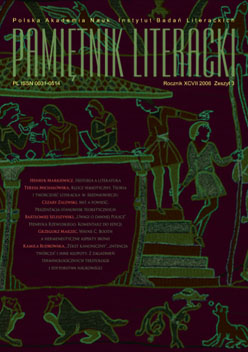Klucz semiotyczny. Teoria i twórczość literacka w średniowieczu
A Semiotic Key. Theory and Literary Formation in Middle Ages
Author(s): Teresa MichałowskaSubject(s): Literary Texts
Published by: Instytut Badań Literackich Polskiej Akademii Nauk
Keywords: middle ages; Latin literature; stylistic theory; "difficult ornateness" (ornatus difficilis); "easy ornateness" (ornatus facilis); semiotics
Summary/Abstract: The article is an attempt to sketch a theoretical basis of stylistic formation in the aesthetic of mature European Middle Ages. The briefly discussed style, characteristic of Latin literature and visual arts (particularly in sculpture and different forms of painting), rooted in a philosophical trend of Platonic world view and in conceptual realism, appeared in literary theory, especially in its two modes known as poetria and ars dictaminis. Its characteristic elements are derived from a stylistic theory called “difficult ornateness” (ornatus difficilis), the core of which the author sees in the practice of hiding the secondary, figurative meanings (sensus transsumptivus) with the use of verbal signs conveying literal meanings (sensus litteralis). This practice gave rise to texts having two semantic layers that required from the reader a hermeneutical effort based on the knowledge of this theory and its detailed rules comprising a mode of creating characters that were embodiments of abstract notions (prosopopoeia). This theory, founded on some elements of antique tradition, developed in 12th and 13th philosophy and well known in Medieval Poland, influenced not only the formation of texts in Latin and later in Polish, but also in Cracow 15th century university treatises (mainly in artes dictaminis), completely unknown to European scholars. The style in question was not the only permissible literary strategy of Medieval writers, since poetics allowed also an “easy ornateness” (ornatus facilis) of texts devoid of semantic duality that was crucial for “difficult ornateness”. Furthermore, the writing practice (also in Poland) dictated a way of speaking with single meaning and without ornateness. A different stylistic rules are observed in the writings composed within the biblical circle; this is, however, a subject of different theoretical and aesthetic-philosophical investigations.
Journal: Pamiętnik Literacki. Czasopismo kwartalne poświęcone historii i krytyce literatury polskiej
- Issue Year: 2006
- Issue No: 3
- Page Range: 29-54
- Page Count: 26
- Language: Polish

